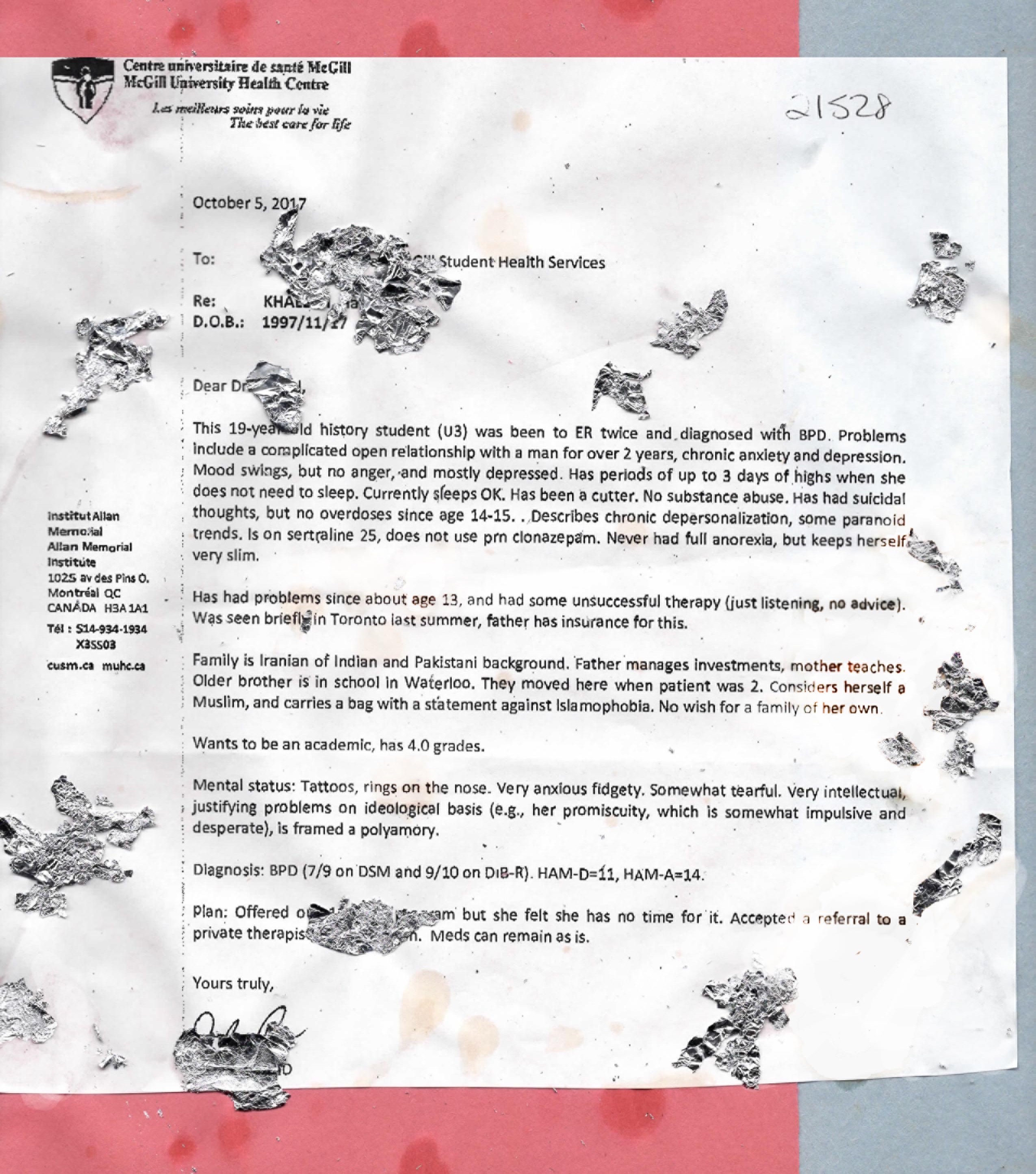content warning: self-harm, eating disorder, suicidal ideation, sexual assault
It’s late spring when a friend of mine informs me that my former clinician — let’s call him Doctor X — withheld a diagnosis from her when she was his patient. She learns this during a crisis appointment with a different psychiatrist, who flippantly mentions a note on her chart which simply states: “personality disorder, not otherwise specified.” A landmine documented in med school handwriting, still active even after two years of concealment. Unsurprisingly, she responds to this information with a panic attack. She is asked to leave the office, to “return when she has calmed down.”
She submits complaints against the clinicians in question. Despite this, they both remain employed and continue to treat students.
. . . . . . . . . . . . . . . . . . . . . . . .
McGill Psychiatric Services charges a dollar per page when photocopying a patient’s chart, with a maximum charge of $25. My request takes a week to be processed. I pick up the thick white envelope at the reception desk. Debit or credit, no cash.
One of the first documents in my chart is a client evaluation form completed on February 9, 2017. Second semester of my second year. I came in for a crisis appointment. It is stated that I have “recurring nightmares about sexual violence.” It is stated that “[they] think [they were] assaulted.” One header on his page of notes is titled “PTSD(?).” His handwriting is difficult to decipher.
My wait time for a follow-up appointment with a psychiatrist is four to six weeks. Five days later, I am hospitalized for self-mutilation. The notes from my medical consultations in the Psychiatric Emergencies Unit state first that I likely have an “unspecified personality disorder with borderline elements,” and then that “BPD is a probable diagnosis.” These notes are forwarded to Psychiatric Services, and then passed onto my soon-to-be-clinician, Doctor X, for follow-up. During a second crisis appointment on February 27, a psychiatric nurse underscores this, advising my future clinician to “rule out [whether I had] BPD or bipolar-II.”
Borderline personality disorder, or BPD, is estimated to impact 1% of the general population, and 10% of those diagnosed will complete suicide. It is characterized by unstable interpersonal relationships, emotional dysregulation, and a shaky sense of self. BPD has a high rate of heritability, and is prevalent amongst individuals with traumatic childhood experiences, such as neglect, abandonment, and abuse.
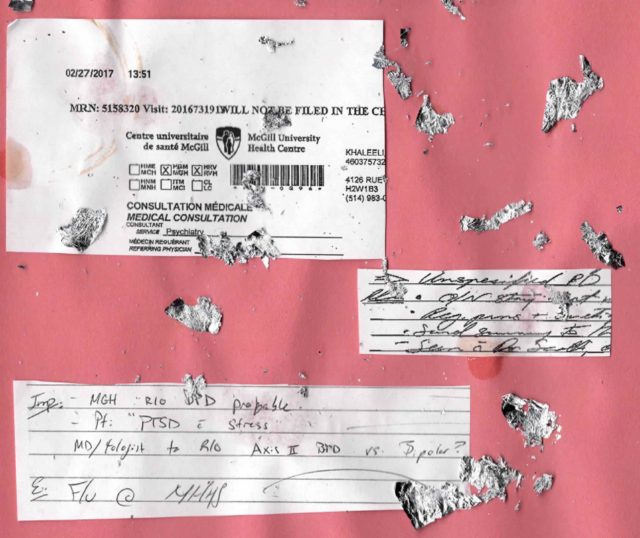
I meet with Doctor X the next day. He does not inform me of this diagnosis, though he makes a small, brief note at the bottom of the page following our initial meeting: “BPD.” Antithetically, he states that my primary diagnosis is for generalized anxiety disorder. I express a desire to focus on my PTSD, which he rejects – it is the anxiety, he claims, which is impacting me most significantly. He gives me a script for escitalopram, an antidepressant. He recommends me to a cognitive behavioural therapy specialist.
The first cylindrical plastic bottle of escitalopram costs me four dollars, thanks to my Studentcare coverage. The next two months are a dissociative blur. Despite my consistent complaints vis-à-vis the negative effects of the prescribed medication, Doctor X makes no note of my declining mental state. My dose is increased at whiplash-inducing rates. I am exhausted, paranoid, and emotionally labile. I am manic, irritable, impulsive. I have delusions about the supposed risk of leaving my apartment. I don’t eat, and I relish the feeling of my ribcage under shaky hands. There is less body left for me to drag around half-heartedly. I spend hours in bed, keeping track of the wall moulding’s intricacies. I buy potted plants and let them dry out on my bookshelf. Chipped mugs accumulate on my bedside table. Water glasses. Bobby pins. At any given time, my body feels as though it is five feet away, uninhabited and superfluous. I dream about being violently assaulted and wake up in a cold sweat. The idea of pain — feeling anything again, regardless of how traumatizing — seems marvellous.
Doctor X’s notes of our appointments rarely exceed five two-word-long lines, and tend towards illegibility. The tight, orderly structure of his writing is somewhat pleasing when it doesn’t sting. Briefly, he mentions the “question of bipolarity,” with no further details. He refers to me as “giggly.” He decreases my dose. On April 13, 2017, he quotes me as saying: “my brain is trying to kill me.” This is all that he writes. He increases my dose. Five days later, he reports that I am “fine now.”
I remember that appointment clearly. I don’t remember much of that year, but I remember that appointment, because I cried for ten minutes straight while telling Doctor X about how much I wanted to kill myself. He seemed at a loss, unmoving in the face of my sadness. Our appointments – booked for an hour-long time slot, as they always are at Psychiatric Services — never exceeded ten minutes. I would always cry. He would usher me out at the ten-minute mark. I was not fine.
Less than a week later, I am hospitalized for the second time.
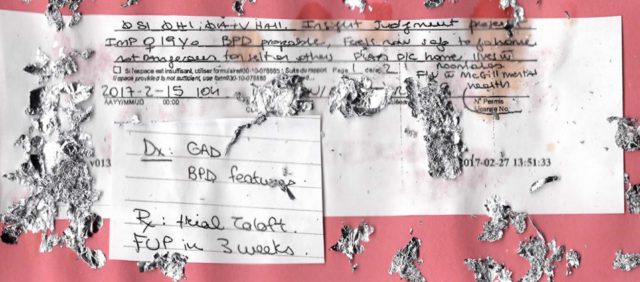
One assessment documents the following: “patient sitting on bed. Appears well groomed, wearing appropriate clothing. Short hair, large glasses. Thin. Multiple fresh cuts on forearms (~30 on left, ~3 on right). Facing window. Increased level of psychomotor activity (running hands through hair, moving fingers). No eye contact. Cooperative but seemed frustrated at having to repeat [their] story… Anxious, labile… Depersonalization: ‘does not know how to make [their] body feel real.’ Good insight.”
And then another: “self-harm with strong BPD traits.” I am described as “help-rejecting,” likely for having stated that I am uncomfortable speaking to a male doctor. “Keep overnight for safety (voluntary).” Nobody offers to clean off my forearms.
The next morning, I wake up to flakes of dried blood on my standard issue sheets. “I believe the main diagnosis is BPD, along with PTSD. Affect is fully reactive. Smiles. Has sense of humour, engages well. Copy of chart to be faxed to McGill.” At this point, they inform me of my personality disorder diagnosis.
I eat breakfast with a plastic fork and knife. Too volatile for real cutlery. A slice of bacon stares at me, dripping grease onto Styrofoam. I don’t eat meat. A med student enters the room as I am changing out of my hospital robe, breasts exposed. “Did the seroquel help you sleep?” he asks.
Given my friend’s experience with Doctor X, I consider receiving my diagnosis during this sojourn at Montreal General to be a godsend. He withheld it from me for two months, but what if I hadn’t been hospitalized a second time? Would I have waited two years? Would I have never been informed of my diagnosis, never been referred to the life-saving practitioners that I’ve been lucky enough, insured enough, unthreatening enough to patronize? The reality of my situation is that suicide was a real possibility, as it is for countless individuals with BPD, especially in the absence of appropriate psychiatric treatment. How do you make sense of personhood after suicidality? I have never known how to picture myself in five years, but I know that I will carry that feeling of constant precarity forever. I was nineteen and I was ready to die. I could have been getting better. I should have been getting better. I repeatedly told Doctor X that his treatment plan was failing me, was hurting me. He didn’t listen. That a clinician could have denied me a chance at recovery should be seen as nothing less than a slap in the face to my autonomy and agency — as a patient, as a person.
I begin to see a new clinician at Psychiatric Services. I am weaned off escitalopram. The withdrawal period is like pulling teeth. I am tired. I am irritable. I look up dialectical behavioural therapy practitioners. I am referred to the Personality Disorders Program at the Allan Memorial Institute. A week and a half passes, and my body has adjusted to life without SSRIs. Doctor X avoids eye contact with me in the lobby of the Brown Building. Sometimes I pass by his office and feel a swelling tide of dread, a visceral urge to vomit.
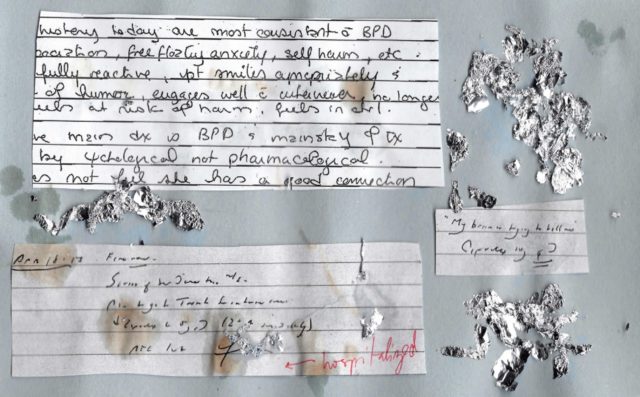
In September of 2017, I meet with the coordinator of the Personality Disorders Program, let’s call him Doctor Y.
He asks me about my eating habits, and I describe a consistent pattern of restricting my caloric intake. “I am unsure,” I say, “whether this actually counts as anorexia.”
He writes: “never had full anorexia, but keeps [them]self very slim.” My ribcage braces itself against taut skin, jutting through my T-shirt. His office is too cold.
He does not document my disclosures of sexual violence.
He writes: “considers [them]self a Muslim, and carries a bag with a statement against Islamophobia.” He writes: “mental status: tattoos, rings on the nose,” as though these could be meaningful markers of traumatic life experiences or neuroses.
I do not discuss my sex life at length. I mention my bisexuality. I mention being in an open relationship. I mention my minor in gender studies, of all things.
He writes: “very intellectual, justifying problems on ideological basis (e.g. [their] promiscuity, which is somewhat impulsive and desperate, is framed as polyamory).”
I meet seven out of nine criteria for BPD. He tells me that my values and intellect will be the primary barrier to effective treatment. I wonder if he has ever said this to a man.
Borderline personality disorder is stringently gendered. This is, in part, because of differential rates of accessing care — men, on average, seek psychiatric help more infrequently.
However, there are other factors at play. Due to misogynistic perceptions of women’s symptomology, they are three times more likely than men to receive borderline diagnoses. Similarly, many psychiatrists have assumed the existence of a link between gender dysphoria and BPD. Additionally, childhood sexual abuse and violence — both of which are disproportionately experienced by girls and young queer and trans youth — are considered to be potential causal elements in the development of BPD.
Misogyny is the thread which ties together this labyrinthine mess of psychiatric malpractice. I think of Doctor X suggesting that we focus on my anxiety, rather than my PTSD. Did he justify this, perhaps, with the assumption that my rape was neither traumatizing nor serious? I think of every note from a consultation or appointment where my survivorhood is not mentioned. What does it mean that Doctor Y saw a facial piercing, or the shape of my body, or a patch on my backpack as more noteworthy than rape? In “Cartographies of Silence,” the feminist poet Adrienne Rich writes:
[Silence] is a presence
it has a history a form
do not confuse it
with any kind of absence.
Omission is telling. It may let us understand what an author has taken for granted in their creation of a source. Why do we allow practitioners to dismiss rape as a reality in their patient’s lives? Where does that leave survivors?
I ask my new therapist about the rationale behind withholding a BPD diagnosis.
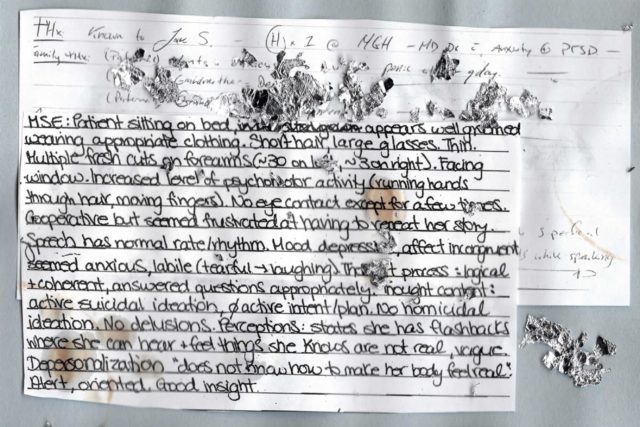 Bee Khaleeli
Bee KhaleeliI was asking for help, wasn’t I? I was asking in all of the ways that I could. I wanted medication that worked. I wanted therapy that worked. I wanted a psychiatrist to see my hurt, to say “you have been hurt,” and to act accordingly. In what world could that be read as volatility? I was asking as clearly and loudly as possible, but I was received by clinicians as a dumb, petulant little girl. A hysteric.
“For what it’s worth,” he assures me, “that coordinator at the Allan has terrible reviews on RateMDs.”
This is comforting for a split second, before I remember that McGill is probably still paying Doctor Y six figures a year.
My therapist thinks that writing this article will be a good outlet. We switch topics.
It is late summer now. I refill my prescriptions for sertraline and clonazepam at Jean Coutu. Little yellow capsules, flat white tablets. The pharmacist asks if I am pregnant or breastfeeding. “God, I hope not!” A joke.
Affect is fully reactive. Smiles. Has sense of humour.
My new psychiatrist says that I no longer meet enough diagnostic criteria to qualify for a BPD diagnosis — just “traits.” She weighed me at our first appointment, and immediately referred me to a dietitian for follow-up. I had a BMI of 16.2.
Keeps [them]self very slim.
My psychiatrist assigns me readings. I complete them without fail.
Help-rejecting
. . . . . . . . . . . . . . . . . . . . . . . .
Months later, in the lobby of Psychiatric Services, I ask Doctor X why he withheld my BPD diagnosis.
“I don’t recall doing that.”
I tell him that I saw my chart.
“I don’t recall you ever asking if you had this diagnosis.”
